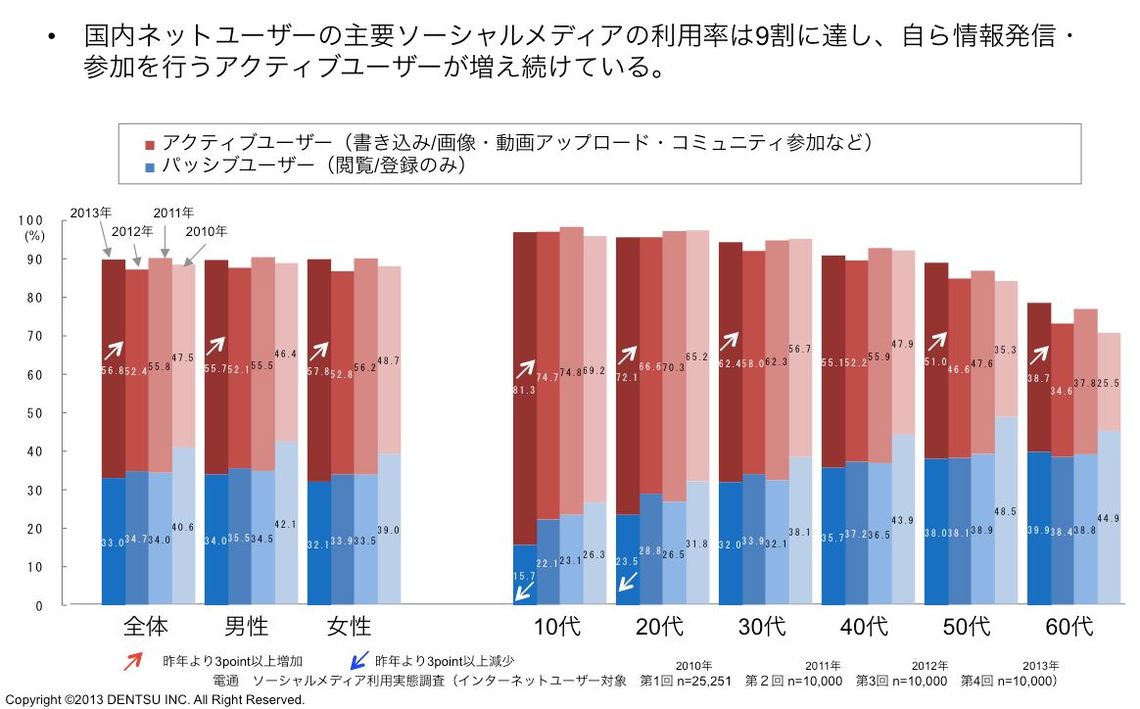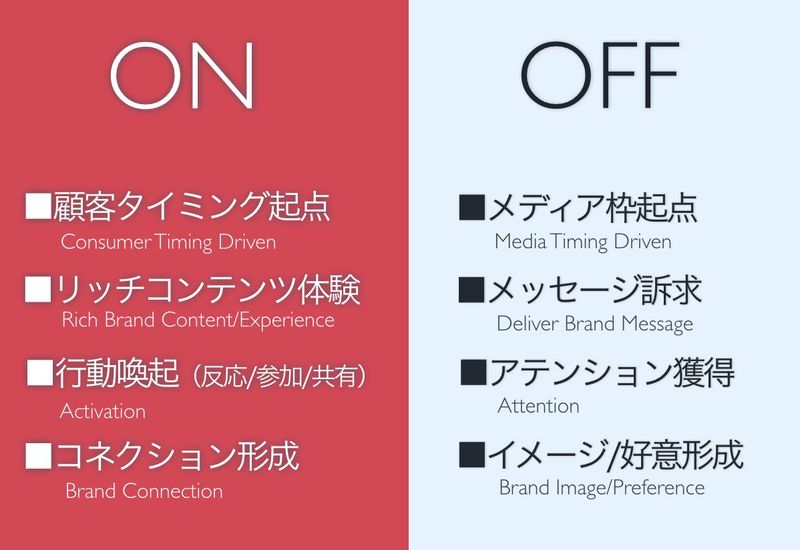Hello. My department assists companies and organizations in formulating and executing brand strategies.
The term "branding" encompasses a wide range of activities. It extends beyond naming, logo development, and advertising to include service development, internal communication, brand content creation, and more recently, digital platform development.
Lately, I've been keenly aware of how the waves of digitalization and globalization are rapidly transforming the nature of branding work.
Here, under the theme "The Present of Brand Strategy Transformed by Digital," I'd like to share a series of my recent thoughts on branding.
On Brand, Off Brand
For the first installment, I'd like to explore the concept of "On and Off" as a key term for branding in the digital age.
Here, On and Off relate to online and offline media, but more fundamentally, they represent the "modes" of our own attitudes and behaviors as consumers.
Today, with smartphones ubiquitous, we can access information 24/7, share topics and experiences via social media, and even shop. Consumers' information engagement styles are also shifting from passive to active engagement ( Figure 1 ).
[Figure 1: With the penetration of social media, users exhibiting active engagement attitudes are increasing]

Beyond merely experiencing the "Off" mode—passively encountering advertising through media—a new "On" mode has emerged. This involves consumers actively searching for and viewing brand-related information and content, sharing opinions, and even making immediate purchases, creating an unprecedented seamless process.
This constant switching between On and Off modes has dramatically accelerated the pace of communication compared to the past.
Companies are creating direct communication channels with customers, delivering content tailored to each individual's interests and timing. They also drive brand interest and purchases by encouraging actions in the "On" mode, such as sharing and participation. For companies, opportunities for so-called "activation" are expanding.
Conversely, if your target audience remains unmoved despite delivering perfectly tailored marketing messages, you might want to consider whether your brand truly resonates as an "On" brand for customers. Ask yourself questions like:
● Is the brand aligning with the "On" timing when customer awareness and interest peak, rather than media-driven timing?
● Rather than one-way messaging, how well does the brand spark customer interest, create relatable experiences, and generate "On" attitudes and actions?
● Are you maintaining a "On" relationship with customers by continuously proposing value that is useful to them, allows them to engage, and can be shared? ( Figure 2 )
Thus, in today's brand competition, merely defining unique value and communicating messages or images through media is insufficient.
[Figure 2: On Brands vs. Off Brands: A Comparison of Customer Experiences]

In my book published last year, "Brand Community Strategy in the Social Era," I also described the shift in thinking from "adjective branding" aimed at image formation to "verb branding" that connects with customers and shares value through action.
What matters most at this point is the behavior of the brand in its "On" state—that is, creating a place and relationship within the customer's life.
Brands must get closer to customers, creating value and experiences rooted in direct connections. They must maintain an "On" relationship by encouraging brand usage and value realization. The resulting sense of proximity and strength of the relationship between the brand and the customer has become a crucial differentiator today.
Should we encourage participation and sharing?
Let's touch on one fundamental question here.
Since social media became integral to our daily communication, it's now standard practice for corporate brand communication to move beyond one-way messaging. Instead, brands plan content and activities that customers will talk about, participate in, and share.
But does designing participatory campaigns or interesting, shareable content truly enhance branding effectiveness?
Certainly, they may generate awareness through buzz, but in reality, many such activities are consumed as "flow" – fleeting communication – and often fade into obscurity without strengthening the brand or driving purchases.
The impact of participation and sharing arises from two key mechanisms: ① Reinforcing memories of brand experiences and episodes through customers' proactive actions in an "On" mode, and ② Expanding support and affinity for the brand through customers' networks.
In other words, for today's branding—where customers themselves create and spread value—the key is not fleeting buzz or content dissemination. Instead, the focus should be on consistently enhancing and sharing the "user experience" of purchasing and using the brand.
This necessitates the following strategic approaches:
● Have an Experience Theme/Story
: Give brand experiences a consistent theme or story so customers become brand storytellers, sharing value through their episodes.
● Maintain relationship platforms
: Foster continuous relationships between each customer and the brand to create a "stock" effect
● Implement mechanisms to strengthen bonds
: Establish systems where customers consciously recognize their bond with the brand and feel validated by actively expressing their fan attitude (through participation and recommendations).
We will explore these approaches in greater detail in future sessions.
Is your brand creating an "On" customer experience? Why not consider opportunities for your marketing activities from these critical perspectives for branding in the digital age?
(Continued in Part 2 and beyond)




